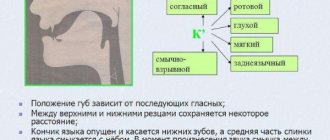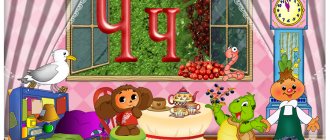Types and causes of violations of the pronunciation of the sound Ш
The distortion of sibilants is called sigmatism. In the case of the sound Ш, various options are possible:
- interdental - the tip of the tongue occupies a position between the upper and lower teeth, which gives a lisp;
- lateral - the tongue lies on its edge and a stream of air flows along its lateral edge. The result is a squelching sound;
- nasal - occurs due to the contact of the back with the soft palate, which, when lowered, opens a passage into the nasal cavity for an air stream;
- labiodental - the original sound is replaced by another unvoiced sound F. For example, cap - “fapka”.
Factors leading to articulation problems:
- physiological: short sublingual frenulum or high palate, malocclusion, tension or weakness of the lingual muscles;
- problems with phonemic and speech hearing, as well as insufficient development of memory, attention, and thinking;
- long-term use of the pacifier. This spoils the bite and leads to distortion of hissing sounds;
- repetition of incorrect pronunciation. For example, a child distorts his speech following adults or younger brothers/sisters.
You can diagnose the problem yourself, but it is better to contact a speech therapist in time.
Summary of a literacy lesson “Sound [Ш] and letter Ш”
Abdulova Dzhume Sirazhutdinovna
Summary of a literacy lesson “Sound [Ш] and letter Ш”
Goal : To consolidate children's knowledge about the sound and letter Sh
Materials: demonstration material, workbooks part 2, a simple pencil, colored pens and pencils, tumblers, counting sticks, felt-tip pens for working at the board
I. Organizational moment
Educator: Guys, listen to the riddle and tell me what sound we will study today
.
Educator : determine what the sound Ш is
Hat, chess, ball (children's answers Sh) cone, tire (children's answers (Sh)
Educator : That's right, the sound Sh is heard. Why? The sound Ш is consonant, dull, always hard.
Articulation of sound
Let's pronounce the sound "SH" together. and now we made the letter w from counting sticks, and also from pencils.
II. Main part.
One child does a task at the board. To the board today is the one whose last name begins with Sh.
This is Sh. Ilya.
(Work in the notebook Elena Astafieva: We play, read, write. Workbook No. 2. Federal State Educational Standard) children write the letter Sh, paint the roof of the house and the tumbler blue, write the letter Sh in their pocket.)
1. Game exercise “Put the letter in her apartment”
Objectives: consolidate knowledge about the studied sound and letter; learn to choose the right and left front house, count the floors in order, starting from the bottom; explain the choice of your decision based on knowledge about sound.
Educator: Guys, look, in your notebook you have drawn a house for letters, the owner of this house is a tumbler. Sh. Ilya placed the letter Sh on the second floor, under the letter K, above the letter S.
Educator: which tumbler do we choose?
Sh. Ilya: blue without a bell
Educator: why?
Sh. Ilya: because Sh is a consonant, deaf, only hard.
2. Game exercise “Continue according to the example”
Goals: consolidate knowledge about sounds and letters. Training a child's visual memory
3. Exercise “Continue the ornament”
Goal: continue according to the example; develop visual memory
4. Exercise “Finish the drawing”
Goal: develop hand motor skills
5. Game exercise “What didn’t the artist draw?”
Goals. We develop visual attention and the ability to identify missing details in an image. We teach the child to form and use adjectives correctly. We consolidate the theme “Animals of the North”.
Progress of the game. The child, recognizing the drawn animals, determines what is missing from each of them; Finds the missing elements in the circles under the pictures and connects the circle with the corresponding picture with an arrow. Then he names the missing elements: deer antlers, walrus tusks, bear paw. At the end of the game, the child fills in the missing details of the drawings and makes a generalization: animals of the North.
6a. Game exercise “Add a syllable”
Goals. Let's introduce the child to the correct spelling of the SHI merger. We consolidate the ability to write SHI in words. We consolidate the knowledge that the sound Ш is always only hard, therefore the fusion SHI is solid.
Progress of the game. An adult introduces the child to the correct spelling of the SHI merger. The child independently enters the missing letter in the merger, crosses out the unnecessary Y, paints over the merger diagram, commenting on his actions; completes the missing syllable in the words under the pictures; draws the sound and syllabic patterns of these words.
6b. Game exercise “Guess, write, name”
Goals. We teach the child to differentiate and write letters with similar elements. We learn to navigate the concepts of row, column and distinguish between them. We learn to correctly determine the serial number of a row (from top to bottom) and column (from left to right). We learn to find the desired letter using a given row and column number.
Progress of the game. The adult introduces the child to what a row and a column are and how to determine their number (the row is counted from top to bottom, the column from left to right).
The child must fill in the empty cells with certain letters. Condition: each column must contain the same letters. Based on this condition, the child names the letters that will be written in each column: 1-P, 2-N, 3-SH, 4-T. Then he fills each row with letters, naming them as he does so.
At the next stage of the game, the adult varies the tasks: the child is given the coordinates of the letter that he must find (Find the letter in the second row of the third column; in the fourth row of the fifth column, etc.).
Diagnostics
It is important to assess how well all components of speech are formed. If there are deviations, speech therapists pay special attention to the appearance of the lips, the tone of the tongue, the state of the bite, the work of facial and articulatory muscles, and the force of exhalation. Standard diagnostic exercises in speech therapy:
- Please show emotions: joy, surprise, sadness.;
- Stretching the lips with a tube and fixing them in a certain position;
- Movements of the jaw in different directions, attempts to relax the tongue, make it wide/narrow;
- Blowing away a light object, playing the pipe;
- Pronunciation of phonemes separately, as well as in words and phrases;
- Compose a story from the given words and pictures.
Based on the results of the examination, suitable exercises are selected for performance. You can use the classic options, widely used in speech therapy.
Articulation of the sound Ш
Correct pronunciation is possible if certain conditions are met. The lips take a “horn” position - slightly rounded and pushed forward. There is a space of about 1 mm between the upper and lower teeth. A wide tongue takes the shape of a “cup” (the sides are pressed against the teeth, and the tip is located behind the upper teeth, leaving a gap between the tongue and the palate).
If everything is correct, then the stream of exhaled air goes in the middle, they are wide and warm. The vocal cords are open, and a dull consonant sound is produced.
It is necessary to regularly perform staging exercises with a speech therapist or at home to achieve the desired result.
Automation of the sound Ш in sentences of 6 words:
A cat and a mouse are embroidered on the pillow. I sew shorts on a sewing machine. I wear a fur coat and a hat with earflaps. I write jokes for Dashutka and Mishutka. The little mouse has crumbs in his hole. Pies with potatoes are good for the road. You'll walk away from a drop, but you'll end up in the rain. You can't clap with one hand. When you speak, think carefully. In the cold the cat does not catch mice. Alyosha and grandfather went to collect pine cones. It’s good to walk along the edge of the forest in the morning. Two jumping frogs made noise at the edge of the forest. I found a bug on a large daisy. Masha rested at the edge of the forest and moved on.
Articulation gymnastics
It is important to carry out the performance in stages - first it is important to create sufficient strength and duration of the output. Speech therapists practice various articulation activities to relax the tongue and practice lifting it. You need to go from simple to complex, increasing the load.
At the first stage of setting the sound Ш, easy but important tasks are given to prepare the muscles of the tongue: make the lips a tube, open the mouth wide for a few seconds, lick the upper lip with a wide, cup-shaped tongue, move the tongue across the palate, from the teeth to the throat.
More complex common exercises for setting Sh:
- "Wide tongue" Ask the child to smile and slightly open his mouth, show his relaxed tongue like a pancake, and then place his tongue on his lower lip. Ideally, you should hold the position for up to 5 seconds;
- “Hide the candy.” Let your baby make a “pancake” of his tongue on his lower lip. Give him a piece of marshmallow or marshmallow and ask him to hide the treat by gluing it to the roof of his mouth behind his upper teeth. The mouth should not open too wide, and the exercise should be done at a slow pace;
- "Fungus". Ask your young student to smile widely and show his teeth, then press his entire tongue to the roof of his mouth. While holding the position, you need to try to open your mouth as wide as possible. It is optimal to perform the task in front of a mirror - the child will see the resemblance of the tongue and frenulum to a mushroom;
- "Groove". This task is important because it teaches you how to form a tubercle on the tongue, which is necessary for setting the Sh. First, your student shows a wide tongue, placing it “pancake-like” on the lower lip and slightly opening his mouth. Then he presses the edge of the tongue in the same position to the side corners of the mouth, the tongue itself narrows a little - the same “groove” is formed;
- "Cup". The tip and lateral edges of the tongue are raised and held in this position. To enhance the effect, a speech therapist or parent can pour a little water into the “cup”.
To avoid difficulties in positioning the Sh during classes, make sure that the child does not rest his entire tongue on the palate.
Staging from other sounds
The method is suitable for children with normal pronunciation of other phonemes from which Sh can be put:
- Through S. We pronounce a long “s-s-s” or stretch out “s-a-a-a”, fix the resulting position of the tongue. While pronouncing, use a spatula or finger to lift the tip of your tongue higher and hold it behind your upper teeth so that it touches the alveoli. Ask the student to exhale while maintaining the tongue position and see how “sa” changes to “sha”;
- Through T. Slowly pronouncing the phoneme with the addition of an aspiration “t-t-t”. We gradually learn to lengthen the air stream and not touch the tubercles on the palate with the tongue;
- Through R. A rare method due to the fact that this phoneme is usually even more difficult for children than sibilants. We keep our mouth open and say a silent R. We stop the vibration with the handle of a teaspoon, resulting in a hissing sound. Each time we use the spoon less and less, thus teaching the child to keep his teeth together and pronounce Sh automatically.
Always start with articulatory gymnastics - the tongue must be prepared for complex work. Warm up - at least 5 minutes. The total duration of classes should not exceed 25 minutes, otherwise children quickly lose interest.
Structure of an individual speech therapy session
- Articulatory gymnastics should begin every lesson. This will help prepare the muscles of the tongue, cheeks, and lips. The duration of this part is about 5 minutes.
- Repetition of what was covered in the previous lesson. If your child has difficulties, you should stop at this stage and go through it again.
- If the child completes the tasks easily, you can move on to mastering more complex stages.
- Games for consolidation of material.
The total duration of classes should not exceed 20-25 minutes so that the baby does not lose interest in them.
Consolidating pronunciation
The speech therapist not only plays the sound, but also automates it. For preschoolers, lessons are structured in an interesting playful way. Approximate plan for stage-by-stage production of Ш:
- We look for the letter in the picture and learn a poem about it.
- We pronounce the syllables sha, sho, shu, after mastering them - ash, ush, osh.
- We consolidate open and closed syllables in conjunction with other phonemes: what, staff, jester.
- We train the pronunciation of words with Ш in the middle and at the end.
- We pronounce short and then more complex sentences with Sh.
We gradually complicate the tasks, fully introducing Sh into free speech. If difficulties arise in the performance, you should not move on to the next stage - it is important to hone your skills consistently. Work everything to perfection - there is no hurry.
Automation of the sound Ш in sentences of 3 words:
Our hut is good. Masha, eat some porridge. Misha eat chocolate. Grandma is embroidering a cockerel. A tractor driver plows the arable land. I hurt my neck. Natasha writes in ink. The horse walked at a walk. Masha eats stew. If you lose it, you won't find it. Misha writes well.




